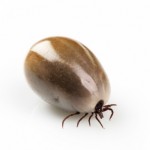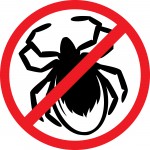The Wall Street Journal recently published an article titled "This Season's Ticking Bomb," discussing the rise of tick-borne diseases, especially focusing on Lyme disease. It said two factors have been important contributors to this global trend: people have moved into turf harboring animal species which often carry ticks and, simultaneously, some kinds of those animals, e.g., squirrels, deer and mice, have increased their numbers.
I must confess I haven't worried much about Lyme disease since our 1999 move to Fort Collins, Colorado, where our back porch is at an altitude of 5,206 feet. Then I found an online 2012 fact sheet from Colorado State University; its subject, "Colorado Ticks and Tick-borne Diseases" gave me pause until I read, "No human cases of Lyme disease have originated in Colorado."
I was amazed to find that ticks here are especially common at higher altitudes; I would have guessed the opposite was true.
We have two species of Colorado ticks that are most relevant to humans: the American dog tick and the Rocky Mountain wood tick. They are three-host blood-feeding parasites, moving from rodents or other small mammals to dogs or deer typically and then, when available, on to human hosts. We're more likely to encounter them in spring or early summer on paths through grassy areas or the brushy zones near the edges of field and woods.
I initially was concerned about the risk of Rocky Mountain spotted fever (RMSF), but it's actually fairly rare here and most common in North Carolina, Oklahoma, Arkansas, Tennessee and Mississippi. From 2,000 to 2,500 cases occur a year in the US with those five states accounting for 60%. They see 19 to 77 cases a year per million while Colorado has 0.2 to 1.5 cases per million. The CDC webpage on RMSF notes the overall incidence of the disease has gone up considerably since 1920, but the fatality rate has plummeted. But in eastern Arizona, through 2009, over 90 cases were noted in a previously RMSF-free area. Ten percent of those who developed RMSF died and there was a marked association with communities with free-roaming dogs.
Colorado Tick fever is seen more frequently in my state than any other infection related to tick bites. It's a viral disease with up to 15% of our campers being exposed, but is not as serious as many other tick-bite-caused illnesses. It usually goes away without causing complications, but 5-10% of those infected with the virus can develop encephalitis, meningitis or, rarely, hemorrhagic fever. Children are more prone to severe acute disease and more likely to have the nervous system complications, but most kids who contract this illness get well quickly. About 70% of adults over 30 may have prolonged symptoms.
Half of those who develop Colorado tick fever have a so-called "saddle-back" temperature curve with initial fever then normal temperature followed by a single fever recurrence.
Tags: Colorado tick fever, Lyme disease, Rocky Mountain Spotted Fver, tick-borne diseases


